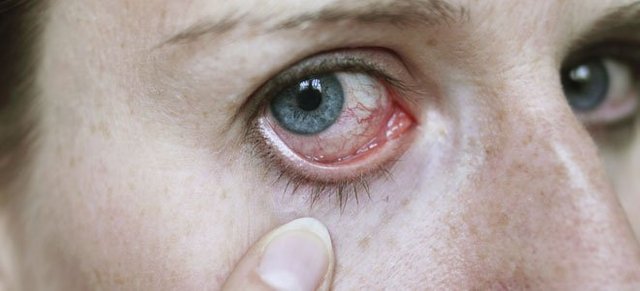Causes of red eyes
Causes of red eyes
Having red eyes can be a symptom of mild irritation or even a serious medical condition, such as an infection. Let's know the causes of red eyes.

Red eyes occur when the small blood vessels on the surface of the eye become enlarged and congested with blood. This occurs due to an insufficient amount of oxygen that is delivered to the cornea or the tissues that cover the eye.
There is usually no reason to worry, but when combined with eye pain or impaired vision, for example, it can indicate a serious medical problem.
Causes of red eyes
Conjunctivitis
It is an infection that includes swelling and irritation of the conjunctiva (a thin, transparent membrane that lines the eyelid and the front of the eyeball). An infection of the conjunctiva irritates the blood vessels causing them to swell.
Viruses cause up to 80% of all cases of conjunctivitis and it is very contagious. The infection usually spreads through direct contact with contaminated fingers or personal items. Conjunctivitis caused by allergies or irritants is not contagious.
Symptoms of conjunctivitis include: itchy eyes, excessive tear production, redness, sensitivity to light, poor vision, and grittiness in one or both eyes.
Corneal ulcer
A corneal ulcer is a lesion in the cornea usually caused by bacterial infections. They often appear as a result of an eye injury, trauma or some other type of damage.
Symptoms of a corneal ulcer may include: red eyes, pain in the eye, sensitivity to light, mild to severe eye discharge, reduced vision, or white spots on the cornea.
People with eyelid disorders, cold sores and those wearing contact lenses risk developing corneal ulcers, as the eyes are very susceptible to irritation of contact lenses, especially if they are not used safely, are not stored correctly or not They are cleaned properly.
Other causes of corneal ulcers include: fungi, parasites, viruses, dry eyes, allergies, generalized infection, abrasions or burns to the cornea or Bell's Palsy.
If not treated properly they can lead to severe loss of vision or even the loss of an eye.
Dry eye syndrome
A person who does not produce enough tears, or tears of sufficient quality to lubricate and nourish the eyes properly, is said to suffer from dry eye syndrome. Symptoms include: itching or burning in the eyes, foreign body sensation, pain and redness in the eye, excessive tears, discomfort when wearing contact lenses, blurred vision, eye fatigue, fibrous eye discharge, discomfort after watching television or reading ...
The dry eye is incurable but can be treated.
subconjunctival hemorrhage
According to the American Academy of Ophthalmology, subconjunctival hemorrhage occurs when the blood vessels of the conjunctiva rupture and cause blood to leak into the area between the conjunctiva and the target of the eye. When this happens, a small amount of blood accumulates under the conjunctiva.
Subconjunctival hemorrhages usually occur because of a minor injury or trauma to the eye. Even rubbing the eye too hard or coughing too hard could cause bleeding. People who have diabetes, high blood pressure or who are taking certain medications may also have subconjunctival hemorrhages.
As they occur on the surface of the eye and, therefore, do not affect the cornea or inside the eye, vision is not affected. It is not painful or causes any strange sensation and usually no treatment is necessary.
Other causes of subconjunctival hemorrhage include: inflammation of the cornea, iris or white of the eye, glaucoma, too much exposure to the sun, dust or other particles in the eye, swimming, drinking or drinking and irritants or environmental pollutants.
Always remember that if in addition to eye pain you also notice sensitivity to light or blurred vision, what you should do is go to your doctor immediately to receive an urgent treatment.


